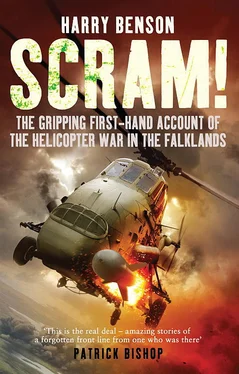Some very rapid planning was now called for. Back on RFA Tidespring , with help from Ian Georgeson, Andy Pulford and Andy Berryman, Mike Tidd set about organising a system of prisoner management and accommodation. Within just eighteen hours, the ship’s team banged together shelves and cushions as sleeping accommodation, and makeshift toilets using forty-gallon drums cut in half with wooden seats fitted.
With help from a detachment of nine Royal Marines from Antrim , a total of 260 prisoners were processed through Tidespring ’s flight deck and down into allocated compartments below. Argentine special forces troops were assigned one magazine, the crew of the Santa Fe the other; the scrap merchants from the original invasion were sent to the now-empty aircraft hangar, and the remaining force of Argentine marines were housed in the hold.
By Saturday 1 May, the force was sailing north toward warmer waters, ultimately to offload the prisoners using the two Wessex that were based at Ascension Island for onward repatriation to Argentina. Altogether the prisoners were on board for two weeks, testing the initiative and patience of Tidd and his team throughout. Problems included how to keep the huge holds warm in the freezing Antarctic waters; how to make sure young naval engineers didn’t shoot one another or themselves with their unfamiliar SMG sub-machine guns; how to apply the more obscure aspects of the Geneva Convention, which had been written for the confines of land and not sea; and how to dissuade the friskier prisoners from causing trouble.
One of those prisoners included the especially troublesome Lieutenant Alfredo Astiz, an army officer known internationally as El Ángel Rubio de la Muerte (‘The Blond Angel of Death’) who was wanted for the forced disappearances, torture and murder of thousands of political prisoners in Argentina in the 1970s. He was eventually segregated from his compatriots and taken north on board Antrim . Although questioned by British police, he was repatriated to Argentina a few weeks later. French and Swedish governments continue to seek his extradition and legal action was renewed against him in Argentina.
Argentine officers in general treated their conscripts like dirt. After observing officers pushing their men out of the way when food was served in the ship’s hold, Tidd caused dismay when he informed the Argentines that, whilst in his care, they would follow the British tradition of feeding the men first and officers second. The prisoners included many Argentines with British connections. One Argentine marine officer commented on the irony that his father was decorated as an RAF Spitfire pilot during the Second World War and now he, the son, was a prisoner of the British. Another was greatly saddened that he was unlikely to be able to take up his place at Oxford University that summer. Several of the submariners had been part of a naval contingent that collected two Type-42 destroyers from shipyards on the Tyne for service in the Argentine navy. Some of the 845 Squadron engineers had joked with the Argentines that they were being taken to a prisoner of war camp in England. ‘Excellent. Could we go to Newcastle? We like Newcastle,’ they asked.
As the prisoners were offloaded from Tidespring at Ascension, Mike Tidd and his team were touched that several Argentine officers came over to shake hands and thank them for the way they had been looked after. In different circumstances, they might have been friends.
Chapter 5
Kicking off: 1–6 May 1982
THE TASK FORCE had sailed from Britain in indecent haste. A huge volume of stores had been piled into ships and needed reorganising, while helicopters and crews were dotted around the fleet unable to contact one another .
Yet an excellent plan was beginning to emerge. The fleet would assemble at Ascension Island, halfway to the Falklands, and use the helicopters to ‘cross-deck’ stores between ships and bring new stores from the air base. The carrier group was to set off and win the naval battle around the Falklands before the amphibious group left the safety of Ascension Island to land the troops on the islands. Throughout the journey south, soldiers, sailors and airmen trained for an assault on the Falklands. Still nobody really thought it would come to all-out war .
Within hours of the carrier group’s arrival off the coast of the Falklands, Britain’s dispute with Argentina was about to get very serious indeed .
* * *
With the demise of Britain’s empire abroad and a tightening of the political purse strings at home, the savage defence cuts announced by Secretary of State John Nott in 1981 called an end to the need for expensive naval aircraft carriers and outdated amphibious landing ships. Britain’s interests would now be focused on her contribution to NATO and the defence of Northern Europe from an expanding Soviet Union. Thus when Argentina invaded the Falklands, Britain’s ageing helicopter carrier, HMS Hermes , was heading for the scrapyard; the first of three new through-deck cruisers, HMS Invincible , had already been sold to the Australians; the commando assault ship HMS Intrepid was in mothballs, and several Royal Fleet Auxiliary supply ships were en route to other navies around the world. Had the Argentines timed their invasion a matter of weeks later, there would not have been enough ships to make up a task force, let alone retake the Falklands.
The task force that sailed from Portsmouth on Monday 5 April amidst much fanfare and razzamatazz had been thrown together with great speed, enthusiasm and ingenuity. National pride was at stake. The two big carriers Hermes and Invincible were earmarked for Sea Harrier operations. With just twenty Sea Harriers initially, the task force was utterly reliant for air defence on this tiny group of vertical and short take-off and landing jets and their two mobile airfields out at sea. Any kind of amphibious landing would be led by the venerable assault ship Fearless , backed by a handful of landing ships logistic. On Friday 9 April, 3 Commando Brigade’s force of Royal Marines (known to all as either ‘royal’ or ‘bootnecks’) and 2 and 3 Para, followed on the requisitioned cruise ship SS Canberra from Southampton. Fearless ’s sister ship HMS Intrepid was rapidly extracted from mothballs and sailed for the South Atlantic on 26 April after a work-up at Portland.
From Fearless , helicopter tasking commander Tim Stanning wondered what kit had made it on board in the mad rush to depart from Portsmouth. Prior to arriving at Ascension, his job would be to put together the immense list of tasks that enabled the helicopter crews to cross-deck stores, troops and equipment from the wrong ships to the right ships. Furthermore, he was also to construct the Helicopter Assault Landing Task sheet, the ‘HEALT’. The plan was to conduct a full-scale rehearsal of an amphibious assault on the Falklands whilst the fleet was at Ascension waiting for events to unfold.
Although Oily Knight and Jack Lomas in their Wessex claimed the prize for being the first junglies to leave Yeovilton, the junglie Sea Kings were the first squadron to leave en masse soon afterwards. Nine aircraft had embarked with Hermes , while three more sailed with Fearless . One other had followed by air with the fourteenth and final Sea King following later on HMS Intrepid along with Mike Crabtree’s Wessex flight.
Even if they were slightly more ungainly and less manoeuvrable, the new Sea Kings were far more powerful than the Wessex they had replaced. Because of their extra size and power, they would be expected to do much of the cross-decking in Ascension and also much of the subsequent offload of ammunition and stores when the time came for an amphibious landing in the Falklands. They had one other remarkable advantage, as yet untested, in the shape of the seven sets of night vision goggles that would allow them to fly at extremely low levels in the dark. All this lay in the future.
Читать дальше












